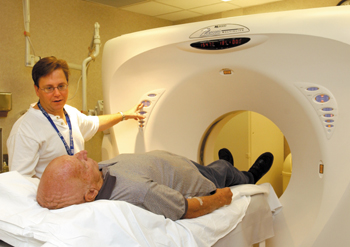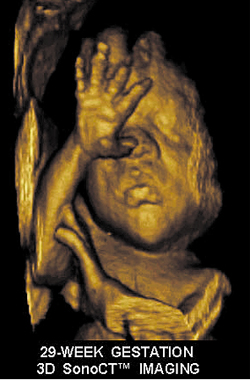
Scott Graham, a CT technologist, uses one of the new multi-slice CT scanners on patient John Kitchen. (photo by Dana Johnson)
Technology offers quicker, detailed views of body

VUMC is the only hospital in the region using the 3-D ultrasound machine.
New state-of-the-art equipment recently installed in Radiology is offering the clinical staff enhanced imaging and increased productivity.
The new equipment includes two multi-slice CT scanners, a digital radiography machine, and a three-dimensional ultrasound.
The multi-slice CT scanners will broaden the patient base of the department, according to Steve Gaines, assistant director of Radiology and Radiological Sciences. The new CT scanners will offer previously unavailable cardiac scoring studies and will enhance vascular imaging due to the speed. “These machines are super fast,” Gaines said.
Installed a month ago, the new machines were placed in the Radiology and Emergency departments.
Radiology now offers four CT scanners – the new multi-slice scanners (Marconi Mx8000 and GE Lightspeed) and two helical scanners. “Hopefully, we will upgrade to have four multi-slice scanners in the future,” Gaines added.
The new Marconi scanner acquires up to four images simultaneously in one half-second, much faster than the helical scanner, which takes one image per second. With just one 15-second breath-hold by the patient, radiologists and CT technologists can instantly acquire images of the chest, abdomen, pelvis, head, neck, and spine.
Introduced in 1998, the GE LightSpeed scanner was the world’s first multi-slice CT scanner and was developed using Design for Six Sigma methodologies.
“It certainly is faster,” said Nita Collins, CT technologist. “We’re glad to have them.”
A new Hologic digital radiography machine was also recently installed at Vanderbilt. The first unit was placed in the offices of the Hillsboro group on MCE 6. A digital unit has also been ordered for 10 North with plans being made to install digital units in the Emergency Department.
The new equipment replaces the use of X-ray film with digital imaging. Now, instead of waiting two to three minutes for film developing, radiologists and technologists can view X-rays in 15 seconds. Speed is not the only advantage of the new equipment. Image quality is also better than conventional equipment, according to Gaines. Film cost will also be decreased. The cost of each sheet of film developed was $2. “Our film budget was well over $1 million,” Gaines added. “Hopefully, this will decrease with the new equipment.”
In addition to cost effectiveness, the new equipment is proving to be time efficient, also. Digital images can also be sent directly to doctors’ computers for viewing.
The new 3-D ultrasound works like the regular machine, only better. The device allows doctors and technicians to view detailed images of the head and extremities to detect such things as cleft lip and palate, according to Dr. Arthur C. Fleischer, professor of Radiology and Radiological Sciences and of Obstetrics and Gynecology. Used primarily when abnormalities in the pregnancy are suspected, the enhanced detail of the images helps in the detection of problems in the womb and fibroids in the uterus.
“This allows us to see things clearer,” Fleischer said. “Parents can understand what the abnormality is with the clearer image.”
The new device is also used for medical concerns other than pregnancy. Radiologists are using the 3-D machine to determine where liver tumors are in relation to vessels. “In the 3-D assessment of tumor blood flow, we are getting better impressions of overall blood flow,” said Fleischer. “This is critical in looking at anti-angiogenesis therapies.”













